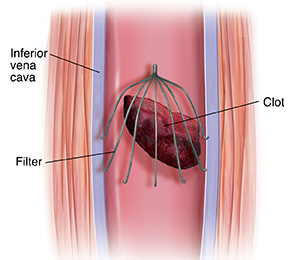Understanding Inferior Vena Cava (IVC) Filter Placement
An inferior vena cava (IVC) filter is a small device that can stop blood clots from going up into the lungs. The inferior vena cava is a large vein in the middle of your body. The filter is put in during a short surgery.

What is DVT?
Veins are the blood vessels that bring oxygen-poor blood back to the heart. A deep vein thrombosis (DVT) is a blood clot that forms in a vein deep inside the body. In most cases, this clot forms inside one of the deep veins of the thigh or lower leg. DVT is a serious medical condition that can cause swelling, pain, and tenderness in your leg. In some cases, a deep clot in a leg vein can break free and stick in a vessel in the lung. This can cause a blockage in the vessel called a pulmonary embolism. Pulmonary embolism can cause severe shortness of breath and even sudden death.
Why IVC filter placement is done
An IVC filter is 1 method to help prevent pulmonary embolism. Your inferior vena cava (IVC) is the major vein that brings oxygen-poor blood from the lower body back to the heart. The heart then pumps the blood to the lungs to pick up oxygen. An IVC filter is a small, wiry device. When the filter is placed in your IVC, the blood flows through the filter but the filter catches blood clots and stops them from moving up to the heart and lungs. This helps prevent a pulmonary embolism.
It's important to understand that an IVC filter does not protect against DVT. You may still get a DVT. The filter helps protect you from a life-threatening pulmonary embolism if you have a DVT.
You might need an IVC filter if you have a DVT or pulmonary embolism. Or have had either of these in the past. Your healthcare provider may advise an IVC filter if:
-
You can't take blood thinner medicine
-
You took blood thinner medicine, and it didn't work
-
You had a complication from taking a blood thinner
How IVC filter placement is done
The procedure is done by an interventional radiologist or a vascular surgeon and a team of specialized nurses. Your healthcare provider will make a small cut (incision) in your groin. This is to reach a major vein leading to the IVC. Your healthcare provider will put a long thin tube (catheter) containing the filter into this vein. Your healthcare provider will use continuous X-rays (fluoroscopy) and move the tube up into the IVC. Your healthcare provider will release the filter into the IVC. The filter will expand and attach itself to the walls of your IVC.
Risks of IVC filter placement
All procedures have risks. The risks of this procedure include:
-
Infection
-
Too much bleeding
-
Allergic reaction
-
Damage to the blood vessel at the insertion site
-
Blockage of blood flow through the vena cava, which can cause leg swelling
-
A filter that travels to the heart or lungs, causing injury or death
-
A filter that pierces through the inferior vena cava, causing pain or damage to other organs
-
Problem with placement of the filter
-
A filter that breaks off and travels to other areas of the body
-
Continued risk of a blood clot that travels to the lungs
-
Kidney failure
IVC filters should be removed as soon as the risk of thrombosis has eased. Or as soon as you can safely take blood thinners.
Your risks may vary based on your overall health, the severity of your condition, and other factors. Ask your healthcare provider about which risks apply most to you.